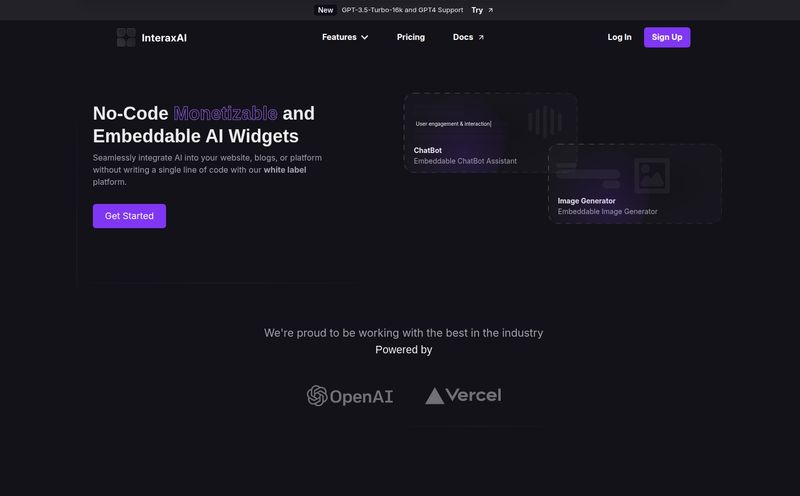I’ve spent more nights than I’d care to admit staring at a Blender viewport, tweaking vertices until my eyes crossed. The process of creating a single, game-ready 3D character can be… an ordeal. It’s a delicate dance of artistry and pure technical grind. You sculpt, you retopologize, you UV unwrap, you bake, you rig. And after all that, you still have to breathe life into it. So when a tool comes along promising to automate the lion’s share of that work, my cynical, battle-hardened SEO brain kicks in. Is it legit, or just more marketing fluff?
We’ve all seen the explosion of Generative AI art with tools like Midjourney and DALL-E. It’s been incredible. But 3D has always felt like the next, much harder frontier. Well, I think we’re finally here. I stumbled upon a platform called MetaBrix, and honestly, it’s one of the few things in the “AI for creators” space that has genuinely made me sit up and pay attention.
So, What Exactly is MetaBrix?
In simple terms, MetaBrix is a SaaS platform that uses Generative AI to spit out 3D characters. But that’s a bit like calling a Ferrari “a car.” It doesn’t quite capture the full picture. This isn’t just about creating static models. The platform is designed to be an end-to-end character pipeline for demanding industries like gaming, the metaverse, and even advanced e-commerce applications. Think of it less as a simple model generator and more as a character-creation engine.
Their whole pitch revolves around accelerating the development process. Cutting down the weeks or months it takes to create a roster of characters to potentially just days or hours. For any studio head or project manager, that’s not just an improvement; it's a revolution in how you budget and plan a project.

Visit MetaBrix
The Core Features That Actually Matter
A feature list is just a list until you see how it fits into a real workflow. And MetaBrix seems to have really thought about the actual workflow of a developer or 3D artist. It's not just a collection of cool tech demos.
From a Simple Prompt to a Full 3D Model
This is the headline act, right? The ability to generate a 3D character from a text prompt (Text-to-3D) or a single reference image (Image-to-3D). We're talking about typing "a grizzled space marine in cyberpunk armor" and getting a usable 3D asset. Or uploading concept art and having it modeled automatically. This is the kind of stuff we were dreaming about on forums ten years ago.
Now, let's be real. Is it going to produce a final, AAA-quality hero character with one click? Probably not, yet. But as a starting point? For creating entire worlds of NPCs? For rapid prototyping? It's an absolute game-changer. It slashes the most time-consuming part of the process—the initial modeling—down to almost nothing.
Making Your Characters... Actually Talk
Here’s where it gets really interesting for me. MetaBrix isn't just creating silent puppets. They have built-in LLM (Large Language Model) integration. This means your newly created character can hold a conversation. They can be infused with intelligence. Suddenly, that NPC you generated isn’t just standing on a street corner; they're a dynamic part of your world that players can interact with in unscripted ways. This moves past tedious dialogue trees into the realm of emergent storytelling. As a former game modder, my mind is racing with the possibilities.
Ready for the Spotlight: Game Engine Integration
A 3D model is useless if you can’t get it into your game. This is a rookie mistake a lot of toolmakers make. But MetaBrix seems to get it. Their characters are built to be “Motion Ready,” with explicit compatibility for major platforms like Unity and Unreal Engine. They even mention Mixamo, which is a huge nod to the indie and prototyping community. It shows they understand that creators need assets that work with the tools they’re already using. No one wants to spend a week trying to get a custom file format to import correctly. It just needs to work. And that includes emotionally expressive facial animations, which is key for creating believable characters, not just lifeless dolls.
The Real-World Impact on Your Workflow
Okay, let's cut through the tech-speak. What does this mean for your bottom line and your sanity? I remember working on a small indie project where our character artist, a brilliant guy named Dave, spent three solid weeks on our main character. Three weeks. With a tool like MetaBrix, Dave could have generated a high-quality base in an afternoon and spent the rest of that time on what really matters: polishing, adding unique details, and creating more assets.
The benefits they list on their site are not just marketing buzzwords; they’re real pain points for developers:
- Accelerated Go-To-Market: Faster content creation means you can launch your game or application sooner. Simple as that.
- Cost-Efficient Graphics: This is huge. The cost of custom 3D asset creation can cripple an indie studio or balloon a corporate budget. This dramatically lowers that barrier to entry.
- Intelligent Engagement: For marketing or metaverse applications, having AI-powered NPCs that can hold real conversations is a massive leap in user engagement over static, clickable characters.
It’s about shifting the work from manual labor to creative direction. You become the director, not the assembly line worker.
Who is MetaBrix Really For?
I see a pretty broad audience here. Indie game developers are the obvious one. The ability to populate a game world with varied characters on a shoestring budget is a dream come true. But I also see large studios using this for rapid prototyping and environmental storytelling.
Then there's the whole other world of e-commerce and metaverse platforms. Imagine a fashion brand creating interactive, AI-powered virtual shoppers to help you find clothes. Or a company building a metaverse training simulation for something as serious as healthcare or banking, where you need to interact with realistic, responsive human avatars. The platform’s mention of these specific use cases shows they’re thinking beyond just gaming.
The Big Question: What's the Catch? (And the Cost)
No tool is perfect, and I'm always skeptical. The provided info mentions it requires JavaScript and potentially some technical skill for integration. That's fair. This isn't a drag-and-drop website builder. It's a professional toolset with an SDK and APIs. You'll need a developer to properly pipe these characters into a custom application. That’s not really a con, just a reality check.
Now, for the million-dollar question: pricing. The fact that the price isn't plastered on the homepage in a neat little three-tiered box tells me everything I need to know. This is most likely an enterprise-level, quote-based service. You're not going to find a '$19.99/month' indie plan here, at least not at first glance. This makes sense when you see their partners and affiliations—NVIDIA Inception, AWS Activate, OpenAI. These aren’t small-time players. This is serious tech, and it will likely have a serious price tag to match, aimed at studios and businesses rather than individual hobbyists.
My advice? If you're a serious studio or business, don't let the lack of a public price scare you. Use their 'Get in Touch' form. The potential ROI in time and cost savings could be massive.
Frequently Asked Questions about MetaBrix
Can I use MetaBrix characters in Unreal Engine 5?
Yes. The platform is designed for compatibility with popular game engines, and they explicitly mention Unreal Engine. The characters are motion-ready, which is exactly what you need for a modern engine like UE5.
Is MetaBrix suitable for a solo indie developer?
It's a bit of a 'maybe'. The technology is perfect for a solo dev looking to speed up asset creation. However, the pricing model seems geared towards studios and businesses. Your best bet is to reach out to them directly to see if they have options for smaller teams or individuals.
How good is the Text-to-3D quality really?
Based on the current state of generative AI, it's realistic to assume the quality is an excellent starting point—a fantastic "first draft." You'll likely still want a 3D artist to do a final pass for hero assets, refining details and ensuring it perfectly matches your art style. For background NPCs, it might be good enough right out of the box.
Do I need coding skills to use MetaBrix?
To generate and customize a character on their platform, probably not. But to integrate that character into your game or app using their SDK and APIs, you will definitely need some technical or programming knowledge. This is a tool for developers and technical artists.
Can the AI characters have custom personalities?
The LLM integration strongly suggests this. The power of Large Language Models is their adaptability. You should be able to shape your character's knowledge base, tone, and personality to create unique, believable interactions, not just generic chatbots.
My Final Thoughts
Look, I've seen a lot of tools come and go. Most are just slight improvements on an old idea. MetaBrix feels different. It feels like a foundational shift. By combining generative AI for model creation with LLMs for interaction, they're not just solving a graphics problem; they're solving a content and interactivity problem at the same time.
It’s still early days for this kind of technology, but MetaBrix is a signal of where we are heading. A future where creation is less about technical hurdles and more about pure imagination. It's a future where a small team, or even one person, can build a world teeming with life and personality. And frankly, that’s a future I’m very excited to be a part of.
Reference and Sources
- The official MetaBrix website: metabrixlab.com
- Information on the NVIDIA Inception program for startups: NVIDIA Inception
- An overview of AWS Activate for cloud support: AWS Activate



